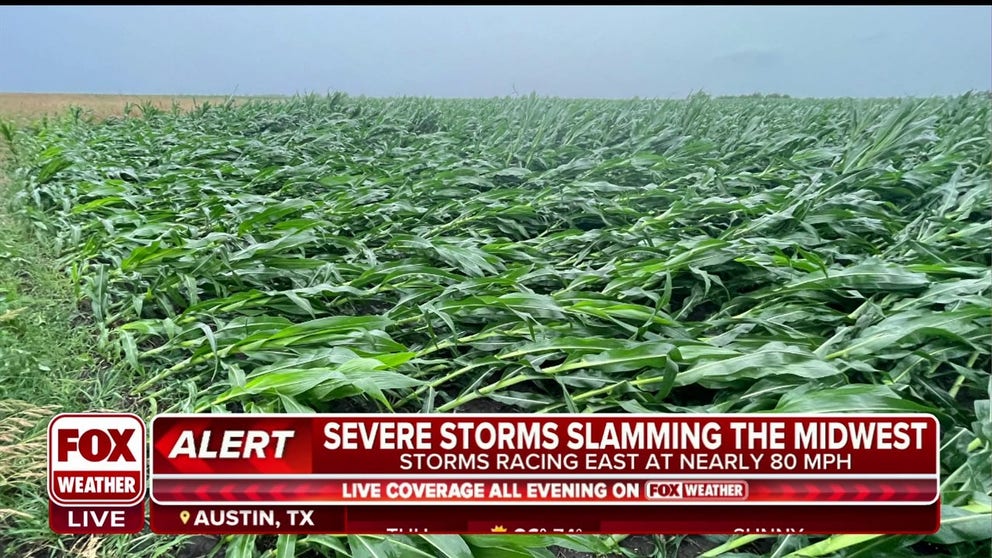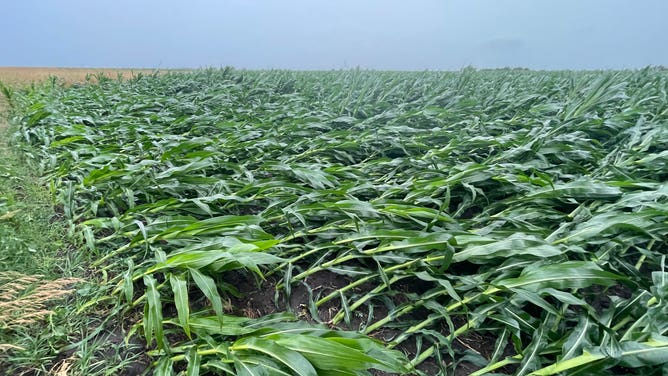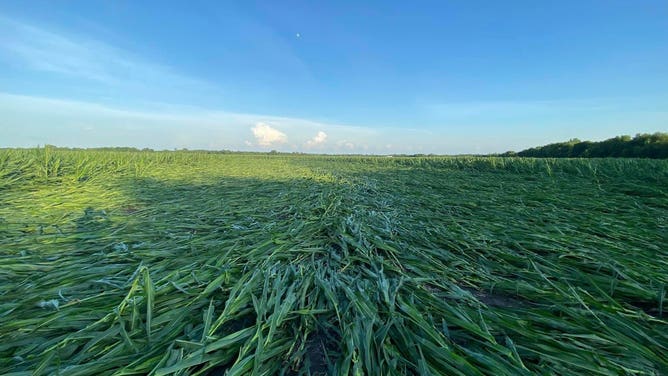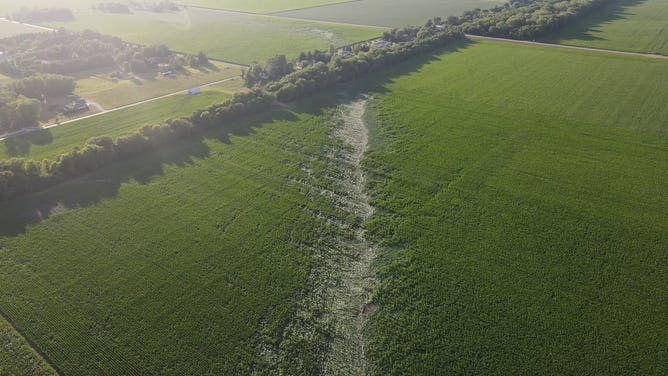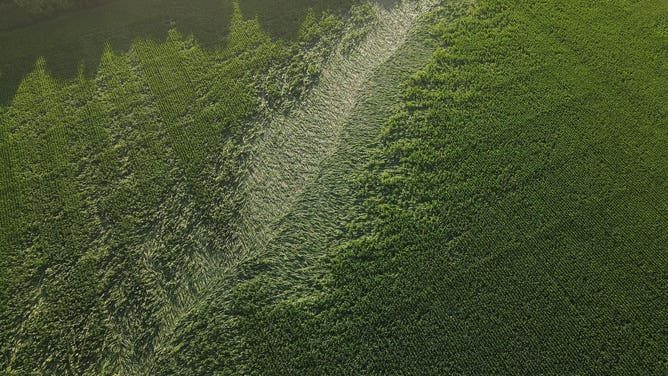Damage to crops from derecho winds fall short of historic 2020 episode
Data showed that the August 2020 derecho was a more impactful event than the recent derecho. The 2020 event produced $11 billion in damage, with corn and soybean crops hard hit in Iowa, Illinois and several other Midwest states.
Crop damage reported in Midwest following Thursday's derecho
A line of severe storms with damaging wind gusts and embedded tornadoes moved through Illinois and Indiana on Thursday. Meteorologist Andrew Pritchard said the damage did not to be as extensive as the August 2020 derecho.
CHANDLERVILLE, Ill. – A week after a deadly derecho marched through the Midwest, damaging power lines and knocking over trees, farmers believe they have escaped the event with less damage than from historical severe weather outbreaks.
On June 29, a line of thunderstorms with winds estimated to be upwards of 100 mph impacted at least eight states, with Illinois and Indiana being home to some of the hardest-hit communities.
The states are among some of the top producers of commodities that include corn and soybeans, which agricultural experts said were already dealing with weather’s hardships before the storms struck.
"We got those rains last week, and if we were talking today and I hadn’t got those rains on my non-irrigated ground - I’d be starting to look at some pretty significant yield losses. The subsoil is still pretty dry, but it bought us time for more rain. And if we get more rain, maybe by harvest time, we’ll find out that we’ll have some pretty good yields," said Steve Turner, an agriculture farmer in Illinois.
DERECHO WITH 100-MPH WINDS RIPS ACROSS MIDWEST LEAVING BEHIND WIDESPREAD DAMAGE
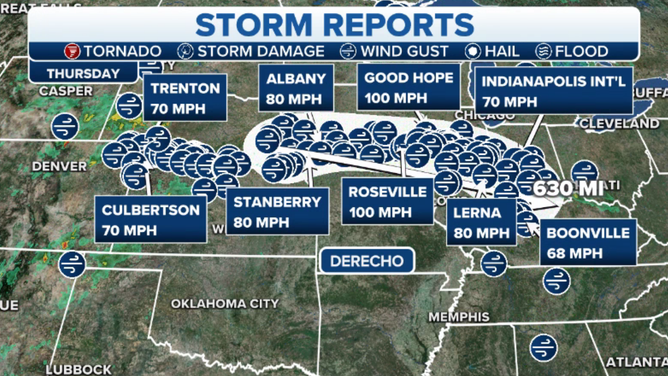
Derecho Storm Reports
(FOX Weather)
Andrew Pritchard, with Nutrien Ag Solutions, was one of the first witnesses to see the damage the storm left behind.
The local meteorologist took several photos of downed corn in the Farmer City community in central Illinois.
"This was not necessarily the same thing that we saw in August 2020, where we had the derecho show come through Iowa and Illinois," Pritchard said. "That was in an entire league of its own where we had those, in some cases, 100-plus-mph winds that lasted for half an hour or more and just really wears down the crops, the trees, and the infrastructure there."
Turner saw damage from the derecho but said his losses were minimal compared to other farmers throughout the state.
"It was pretty hit-and-miss, but when I say that, it starts adding up. A farmer in New Berlin had 300 acres that was damaged. And you start doing that here and there, and that’s when your damages add up," said Turner.
In some cases where corn appeared to be flattened, farmers say the impacts were just temporary, and stalks could eventually go back to becoming more vertical by harvesting season.
HOW CORN MAZES ARE ECHOES OF ANCIENT LEGENDS AND TRADITIONS
June 2023’s derecho was not a repeat of August 2020
The term "derecho" wasn’t edged into the vocabulary of many Americans until the costliest severe thunderstorm event in the country’s history unfolded on August 10, 2020.
The long-lived line of thunderstorms produced damage in nearly a dozen states during a trek of more than 700 miles.
The strongest winds were thought to have hit Cedar Rapids, Iowa, where gusts were estimated to be 140 mph.
More than 1,000,000 power outages were reported, and damage estimates topped $11 billion.
The line of storms produced damaging wind gusts for more than 30 minutes in many communities, adding insult to injury.
"So, it is unfortunate to see some of the damage, especially in the towns and to the crops there. At the same time, it’s not quite as bad as we saw in 2020. I think it was better here to have a situation where the winds are lasting 10 to 15 minutes compared to the 30 to 45 minutes in 2020," Pritchard said.
In addition to the differences in the potency of the storm system, the recent derecho event faced corn fields that were shorter due to the drought and more advanced seeds that have made the crop more reliable in recent years.
"The hybrid genetics is probably what made the corn hang in there through the storms and until we got the rain. Ten to fifteen years ago, we probably would have had a different situation," said Turner.
Iowa Senator Chuck Grassley recently took a selfie in a Hawkeye State cornfield and credited seed genetics for allowing the crops to be as tall as they are while facing the extreme weather.
WHAT SEASON DO FRUITS AND VEGETABLES GROW IN?
Time remains for crop improvements
Despite the drought and severe weather, Turner believes crops are in a better position than after the derecho in 2020.
"So, I’m smiling as a farmer with this rain. I’m seeing my non-irrigated corn look a lot better, but I’m also going to need luck to get more rain to get us through," said Turner.
The longtime Illinois farmer believes an inch of rain per week during the next month and a half would help get corn and soybeans to a healthy position for fall harvest.
Corn is expected to hit harvest in August and September, with soybeans coming slightly after.
"One drought cycle or one year of having real down yields can have an effect on supply and food prices. But let’s remember, for a lot of the food chain out there, we are just cents on the dollar of the final cost of food. There’s a lot of processing, and other things are added onto it, and that’s where the costs go up," said Turner.
